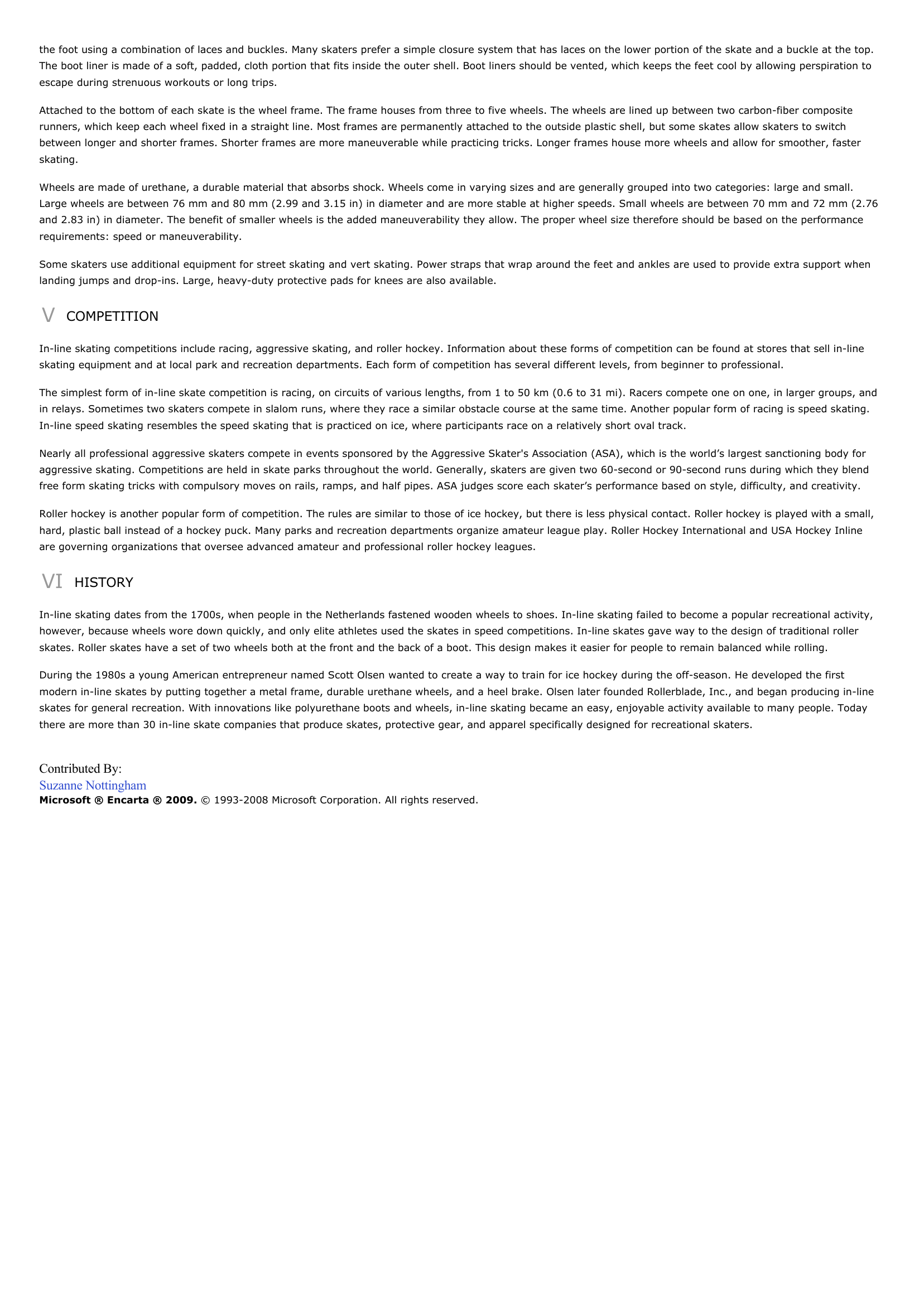In-Line Skating.
Publié le 14/05/2013

Extrait du document
«
the foot using a combination of laces and buckles.
Many skaters prefer a simple closure system that has laces on the lower portion of the skate and a buckle at the top.The boot liner is made of a soft, padded, cloth portion that fits inside the outer shell.
Boot liners should be vented, which keeps the feet cool by allowing perspiration toescape during strenuous workouts or long trips.
Attached to the bottom of each skate is the wheel frame.
The frame houses from three to five wheels.
The wheels are lined up between two carbon-fiber compositerunners, which keep each wheel fixed in a straight line.
Most frames are permanently attached to the outside plastic shell, but some skates allow skaters to switchbetween longer and shorter frames.
Shorter frames are more maneuverable while practicing tricks.
Longer frames house more wheels and allow for smoother, fasterskating.
Wheels are made of urethane, a durable material that absorbs shock.
Wheels come in varying sizes and are generally grouped into two categories: large and small.Large wheels are between 76 mm and 80 mm (2.99 and 3.15 in) in diameter and are more stable at higher speeds.
Small wheels are between 70 mm and 72 mm (2.76and 2.83 in) in diameter.
The benefit of smaller wheels is the added maneuverability they allow.
The proper wheel size therefore should be based on the performancerequirements: speed or maneuverability.
Some skaters use additional equipment for street skating and vert skating.
Power straps that wrap around the feet and ankles are used to provide extra support whenlanding jumps and drop-ins.
Large, heavy-duty protective pads for knees are also available.
V COMPETITION
In-line skating competitions include racing, aggressive skating, and roller hockey.
Information about these forms of competition can be found at stores that sell in-lineskating equipment and at local park and recreation departments.
Each form of competition has several different levels, from beginner to professional.
The simplest form of in-line skate competition is racing, on circuits of various lengths, from 1 to 50 km (0.6 to 31 mi).
Racers compete one on one, in larger groups, andin relays.
Sometimes two skaters compete in slalom runs, where they race a similar obstacle course at the same time.
Another popular form of racing is speed skating.In-line speed skating resembles the speed skating that is practiced on ice, where participants race on a relatively short oval track.
Nearly all professional aggressive skaters compete in events sponsored by the Aggressive Skater's Association (ASA), which is the world’s largest sanctioning body foraggressive skating.
Competitions are held in skate parks throughout the world.
Generally, skaters are given two 60-second or 90-second runs during which they blendfree form skating tricks with compulsory moves on rails, ramps, and half pipes.
ASA judges score each skater’s performance based on style, difficulty, and creativity.
Roller hockey is another popular form of competition.
The rules are similar to those of ice hockey, but there is less physical contact.
Roller hockey is played with a small,hard, plastic ball instead of a hockey puck.
Many parks and recreation departments organize amateur league play.
Roller Hockey International and USA Hockey Inlineare governing organizations that oversee advanced amateur and professional roller hockey leagues.
VI HISTORY
In-line skating dates from the 1700s, when people in the Netherlands fastened wooden wheels to shoes.
In-line skating failed to become a popular recreational activity,however, because wheels wore down quickly, and only elite athletes used the skates in speed competitions.
In-line skates gave way to the design of traditional rollerskates.
Roller skates have a set of two wheels both at the front and the back of a boot.
This design makes it easier for people to remain balanced while rolling.
During the 1980s a young American entrepreneur named Scott Olsen wanted to create a way to train for ice hockey during the off-season.
He developed the firstmodern in-line skates by putting together a metal frame, durable urethane wheels, and a heel brake.
Olsen later founded Rollerblade, Inc., and began producing in-lineskates for general recreation.
With innovations like polyurethane boots and wheels, in-line skating became an easy, enjoyable activity available to many people.
Todaythere are more than 30 in-line skate companies that produce skates, protective gear, and apparel specifically designed for recreational skaters.
Contributed By:Suzanne NottinghamMicrosoft ® Encarta ® 2009. © 1993-2008 Microsoft Corporation.
All rights reserved..
»
↓↓↓ APERÇU DU DOCUMENT ↓↓↓
Liens utiles
- staff and line.
- PAL (Phase Alternative Line), système de codage du signal d'émission de la télévision en couleur mis au point en 1963 par Walter Buch, de la société Telefunken.
- America On Line [AOL] (entreprise).
- Renaud, Line - acteur / actrice.
- Poissons: Acanthurus line atus.












